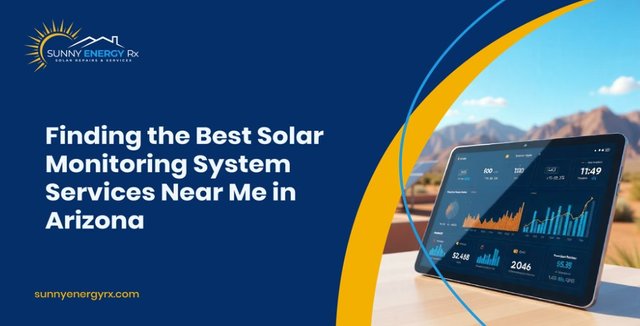The Arizona Shortcut to Finding Solar Monitoring You Can Trust
This blog was originally published on Sunny Energy RX.
Your panels soak up Arizona sun all day. Real peace of mind comes from a monitoring setup that tells you what is happening in plain language. If your app looks noisy or your bills feel off, the answer is not another gadget. It is a local partner who understands your hardware and our desert realities. Use this shortcut to go from search overload to a short list of trustworthy pros in Phoenix, Tucson, Mesa, Chandler, and beyond.
Start by Defining What You Want
Write down three things: your inverter brand and app, any extras like a battery or EV charger, and the kind of support you expect. Some homeowners want a clean dashboard and alerts that make sense. Others want proactive oversight, seasonal tune ups, and help with warranty claims. Clarity now keeps you from chasing the wrong fit later.
Build a Focused Shortlist
Begin with your equipment maker’s provider finder. Enphase, SolarEdge, SMA, and Tesla are common in Arizona, and platform fluency cuts setup time.
Add a city based search for solar monitoring and read the most recent reviews. Look for patterns like fast diagnosis, clear communication, and successful fixes for low production. Ask neighbors or community groups which companies actually showed up when something broke. Real experiences matter more than polished ads.
Confirm They Can Support Your Gear
Before anyone visits, verify platform fluency. Ask which portals the team uses every week and request two active systems like yours under their care. If you have a consumption meter, confirm they will connect it so production and household usage appear on one timeline. True fluency shows up in specifics, not buzzwords.
Look for Arizona Specific Know How
The desert leaves fingerprints on your data. Thin dust films that slowly mute output. Long hot afternoons that nudge inverter performance down. Monsoon bursts that rinse glass yet leave splash back residue or knock a gateway offline. A strong provider can describe how these patterns appear in the graph and how they separate weather noise from real faults.
What a Real Monitoring Program Includes
Expect a clear baseline for healthy production on typical bright days in your area. If your hardware supports it, enable consumption reads so you can see roof and home on the same timeline.
Alerts should cover offline events, repeated midday dips, sudden drops that do not recover, and zero readings during bright hours. Reports should align with your utility rate plan so you can time flexible loads to the highest value hours.
Questions That Reveal Real Expertise
Use this script on discovery calls:
- How do you define a normal clear day curve for my neighborhood
- Which alerts will you set and who receives them
- What happens after an alert fires and how quickly do you reach me
- Do you maintain systems like mine today and can you share two local references
- Will you help with manufacturer claims if an inverter, optimizer, or gateway fails
- What is included in routine monitoring and what counts as billable work
You are listening for simple steps, real timelines, and examples from Arizona homes.
Red Flags That Save Time
Move on if a company cannot name your app or dodges license questions. Be wary if they push a brand new system when you asked for monitoring help.
Reviews that mention no shows or slow responses are reliable warnings. If they dismiss consumption monitoring even though your gear supports it, keep looking.
Pricing That Brings Clarity
Ask for a written outline that covers setup, ongoing remote monitoring, scheduled inspections, on site troubleshooting, and optional cleaning. Many Arizona homeowners prefer an annual plan that bundles oversight with a routine inspection. Predictable fees often prevent larger losses by catching quiet performance drift during long bright months.
What Your First Visit Should Accomplish
The technician should verify data feeds from your inverter and any consumption meter. They should set alert thresholds you understand and walk you through a live view of a healthy clear day for your roof.
A quick scan for shade lines and debris is standard, along with checks of mounts, flashing, conduit, and inverter ventilation. You should end with a saved baseline screenshot and a seasonal plan that fits dust and monsoon cycles.
When to Call Right Away
Do not wait if your app shows zero during bright hours. Act on a sudden cliff that never recovers on a clear day. Reach out if the portal stays offline longer than a day. Repeating dents at the same time each day often point to new shade or a device that needs attention. New to the home with solar? Book a monitoring health check to set a clean baseline for the year.
Ready to turn confusing graphs into steady savings? Choose Sunny Energy RX for local expertise, fast diagnosis, and dashboards that make sense at a glance. Bright sun on your roof and clear answers on your phone is the Arizona way, and we are here to make every ray count.
